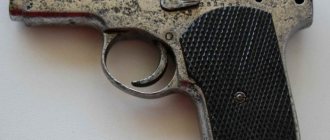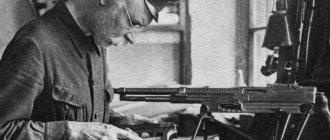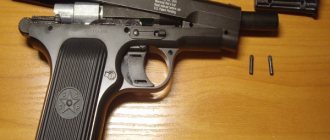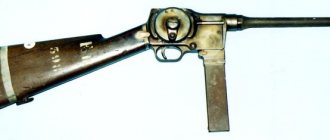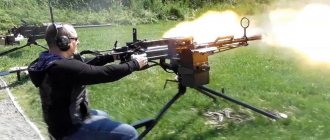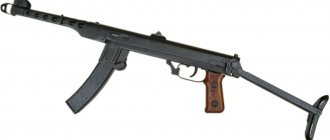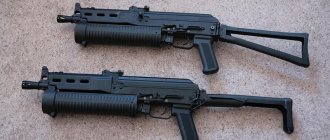Tokarev submachine gun 1927
On October 27, 1925, the Red Army Armament Commission decided:
consider it necessary to re-equip junior and middle command personnel with an automatic submachine gun, leaving the Nagan in service with senior and senior command personnel
The Tokarev submachine gun was created by F.V. Tokarev for a slightly modified 7.62-mm revolver cartridge of the Nagan system, since at that time pistol cartridges were not produced in the USSR (in the tsarist army, from which the small arms system passed to the Red Army, standard pistols did not have). The Nagant cartridge was unsuitable for use in automatic weapons, so the cartridges for experienced submachine guns were modified: the cartridge case muzzle was compressed onto a cone to facilitate feeding into the chamber.
Subsequently, work on the creation of submachine guns, both for revolving and pistol cartridges (7.63x25 mm Mauser, adopted in the USSR in the early 1930s as 7.62x25 mm) was continued. Adaptation of the Tokarev PP for the 7.62 mm Mauser-Tokarev pistol cartridge was attempted, but was unsuccessful.
On the basis of the submachine gun, Tokarev also made a self-loading carbine, which featured a longer barrel, a modified front sight and a sector diopter sight for 800 m.
Almost all weapon parts were made on metal-cutting machines. Along with this, there was also an option with a more technologically advanced receiver made from a tubular blank, which goes into a perforated barrel casing. The number of factory parts is 81.
The Report of the Revolutionary Military Council of the USSR dated December 1929 stated that:
The adopted system of infantry weapons of the Red Army provides for in the near future the introduction into service of a semi-automatic self-loading rifle... a self-loading pistol... a submachine gun as a powerful automatic melee weapon (there are samples, a magazine for 20-25 rounds, a range of 400-500 meters)
Although the Tokarev PP was not officially adopted for service, a significant number of copies of this weapon were produced - according to various sources, from 300 to 600, that is, quite comparable to the scale of production of the PP at the initial stage of development in production; a fairly large number of cartridges for it were also fired. Some of the submachine guns ended up with the troops. There are even known cases of their use during the Great Patriotic War (in January 1942 on the Kalinin Front).
Next came the Degtyarev submachine gun (model 1929 - not to be confused with the later PPD). It was created by V.A. Degtyarev in 1929 based on the design of his own DP machine gun. It had a semi-free bolt with lugs diverging to the sides, and a receiver and disk magazine design very similar to the DP.
Not mass produced.
The funny thing is that since 1916 Russia had in serial production at the Kovrov plant (now the Degtyarev plant) a normal Fedorov assault rifle chambered for the 6.5x50 mm Arisaka intermediate cartridge with a muzzle energy of 2615 J (versus 3600-4000 J for the standard Russian 7.62 mm rifle cartridge). Moreover, this cartridge was mastered by the Petrograd Cartridge Plant (200-300 thousand of these cartridges were produced per month - this is quite a significant amount).
Based on this machine gun, quite decent light light, tank, and aviation machine guns were developed.
The design of the machine is quite rational:
The Fedorov assault rifle operates on the principle of using recoil with a short barrel stroke with a bolt frame recoil accelerator. The shutter is locked by two swinging larvae, located symmetrically on both sides and rotating in vertical planes. During a shot, when the barrel moves back, these larvae turn and release the bolt. After this, he can freely move to the rearmost position. When the larvae turn, their rear ends press on the protrusions of the bolt, accelerating its withdrawal and thus allowing more energy to be removed from the coupled barrel-bolt pair.
The hammer-type trigger mechanism allows for both single and automatic fire. Early versions of the machine gun (before 1923) had a detachable fire selector. This detail was given to the fighter after passing a kind of exam. The version of the machine gun improved in 1923 (it makes sense to talk about the 1923 model) did not have a removable fire switch.
The receiver and bolt body are obtained by soldering steel parts of simple shape in the jigs with copper. The parts were processed with files, which determines the quality of the steel used (the hardness of the file is known, it will not hurt hard steel). This makes the Fedorov assault rifle attractive for manufacturing in handicraft or semi-handicraft conditions. At home, it is impossible to make just a drilled and drawn barrel and cartridges... However, the final mass of the weapon is significantly less than its closest foreign analogues.
In 1923, the machine gun received a new magazine, with a changed bending radius and other parameters. According to some reports, it is very close to the magazine of the German MG-18 light machine gun, but without the bolt stop. The magazine capacity is 25 rounds, but judging by the photographs, there was an attempt to create a 50-round magazine. Subsequently, a multi-storey disc magazine was developed based on the Lewis machine gun.
By the way, here is OSNAZ with Fedorov assault rifles:
Strictly speaking, the 6.5x50 mm Arisaka cartridge is a rifle cartridge, but a weakened one. It was created by the Japanese when it turned out that the recoil of “European” cartridges was too great for the short little Japanese. When used from a relatively short-barreled weapon, which was the Fedorov assault rifle, this cartridge turns out to be close in energy to modern “intermediate” high-power cartridges. For comparison, the muzzle energy of a modern 5.45x39 cartridge when fired from an AK-74 is 1360-1430 J - almost two times lower than that of the 6.5x50 mm Arisaka from a Fedorov assault rifle. It follows from this that Fedorov’s assault rifle had somewhat excessive recoil, but it made a light machine gun that was simply excellent, light and quite powerful. Well, the ballistics of the cartridge are much more suitable for accurate single shooting - which is what OSNAZ noted.
In 1940, during the Winter War with Finland, a number of machine guns again entered the troops fighting in Karelia, where they proved themselves to be excellent. The main problem with the machine gun was not design flaws, but the low quality of construction materials - settling of parts, metal deposits, etc., as well as the low quality of ammunition supplied to the troops.
In the 1920s, based on the design of the Fedorov assault rifle, a family of unified prototypes of small arms (not mass-produced) was developed:
6.5-mm light machine gun of the Fedorov-Degtyarev system - prototype of 1921, with a water-cooled barrel and bipod 6.5-mm light machine gun of the Fedorov-Degtyarev system - prototype of 1922, with air-cooled barrel and 6.5-bipod mm aviation machine gun of the Fedorov-Degtyarev system - prototype of 1922 6.5-mm coaxial machine gun of the Fedorov-Degtyarev system - prototype of 1922, powered from disk magazines for 50 rounds 6.5-mm coaxial machine gun of the Fedorov-Shpagina system - experimental model of 1922, fed from box magazines with 25 rounds of ammunition 6.5-mm triple machine gun of the Fedorov-Shpagin system - prototype of 1925 6.5-mm coaxial tank machine gun of the Fedorov-Ivanov system, improved by G. S. Shpagin - prototype 1925 (with a ball mount, for installation in the turret of the MS-1 tank)
The Fedorov assault rifle was in service with the Red Army until 1928. In 1928, the People's Commissariat of Armaments of the USSR decided to stop all work on weapons chambered for the 6.5 mm cartridge and to develop machine guns for the Red Army chambered for the standard 7.62×54 mm R cartridge. Thus, Fedorov's entire legacy was ruined, and the USSR remembered “intermediate cartridges” only when intelligence officers from Germany reported about work being carried out there in this direction.
In Germany, it all started with the development by Polte (Magdeburg) of an intermediate cartridge 7.92x33 mm for shooting at a distance of up to 1000 m, in accordance with the requirements put forward by the HWaA (Heereswaffenamt - Wehrmacht Weapons Office). In 1935-1937, numerous studies were carried out, as a result of which the initial tactical and technical requirements of the HWaA for the design of weapons chambered for a new cartridge were reworked, which led to the creation in 1938 of the concept of light automatic small arms, capable of simultaneously replacing submachine guns in the army, repeating rifles and light machine guns. This weapon received the code name schwere Maschinenpistole - heavy submachine gun. Schmeisser, who headed the design team, handed over the first prototype of the machine gun to the HWaA at the beginning of 1940. At the end of the same year, the contract to conduct research on the MKb program was awarded to the Walther company under the leadership of Erich Walter. The machine gun of this company was presented to the officers of the artillery and technical supply department of the HWaA at the beginning of 1941. And only then did the USSR begin to itch.
Description[edit]
The Tokarev 1927 is a blowback weapon capable of selective fire using two triggers. The rear trigger fired a single shot, while the front trigger was fully automatic. The butt of the pistol has a cavity for storing an additional magazine. The weapon has a sight at 100 or 200 meters, adjustable by tilting up one of the two eyes on the receiver. A prototype carbine was also made; it has a single trigger, a slightly longer barrel and adjustable sights out to 800 meters, despite using the same weak cartridge; Examples of both variants can now be found in the Military Historical Museum of Artillery, Engineers and Signal Corps in St. Petersburg. [3]
Blacksmith's Apprentice
Even those who are not interested in weapons have heard about the TT pistol, also known as the “Tula-Tokarev”.
In the 1990s, the TT, once created for army needs, became the favorite weapon of killers. It is unlikely that the creator of the legendary pistol would have been happy about this fate of his brainchild. Much less is known about the weapons designer Fyodor Vasilyevich Tokarev He never strived for fame and popularity, preferring to devote as much time as possible to work.
Fyodor Tokarev was born on June 14 (new style) 1871 in the village of Yegorlyk region of the Don Army in a Cossack family. As a child, Fedya was reserved and quiet, and he preferred the company of a local blacksmith master to playing with his peers, in whose forge he spent whole days.
Already at the age of 7, to the considerable surprise of adults, Fedya independently made a small plow out of wood and tin. By the age of 11, he easily performed work that only a mature master could do.
Esaul of the 29th Don Cossack Regiment F.V. Tokarev. Photo: Commons.wikimedia.org
When he, already an accomplished designer, was asked how he became a gunsmith, Tokarev shrugged his shoulders: “In my opinion, it happened by accident. As a child, I came across a gunsmith and became very fascinated by his work.” Indeed, one day a gunsmith from the Tula factory found himself in the forge where Fedor worked. His story about the profession captivated the young man.
Thirty years later
Self-loading and automatic Tokarev rifles (SVT-38, SVT-40, and AVT-40) were created by the designer on the eve of the Great Patriotic War. It took thirty years to create samples of weapons, which Tokarev began working on back in Oranienbaum.
Article on the topic
Peacetime weapons: the history of the creation of the Makarov pistol Unlike the TT, Tokarev rifles quickly began to give way to new types of weapons. In an effort to keep up with the times, in October 1943 the designer began work on an assault rifle based on the AVT-40 rifle.
The Tokarev assault rifle (AT-44) was presented for field testing in May 1944. However, the military was not satisfied with their results. After modification, the new model was presented in December 1944, but the AT was inferior to its competitors, and its further development was considered inappropriate.
The designer was already over 70 years old, had a huge life behind him, and Soviet awards were added to the tsar’s awards: the title of Hero of Socialist Labor, the Order of Lenin and the Red Banner of Labor, the Stalin Prize of the first degree for developing the design of a new type of small arms.
The time had come for a new generation of gunsmiths who continued the work of Tokarev.
Carbine of the Fyodor Vasilyevich Tokarev system, model 1935, from the collections of the Central Museum of the Armed Forces of the USSR. Photo: RIA Novosti/V. Shiyanovsky
Links[edit]
- ^ a b c d
Bolotin, David (1995). History of Soviet small arms and cartridges (in Russian). Polygon. pp. 101–105 and 19. ISBN 5-85503-072-5. - Monetchikov, Sergei (2005). History of the Russian assault rifle [ History of the Russian assault rifle
]. St. Petersburg: Military Historical Museum of Artillery, Engineers and Signal Corps. pp. 18–19. ISBN 5-98655-006-4. - ^ a
b Mikhail Degtiatev, » First domestic.
Tokarev submachine gun chambered for a revolver cartridge » // Kalashnikov.
Weapons, ammunition, equipment (Kalashnikov magazine) 2009/1, pp. 70–73.

